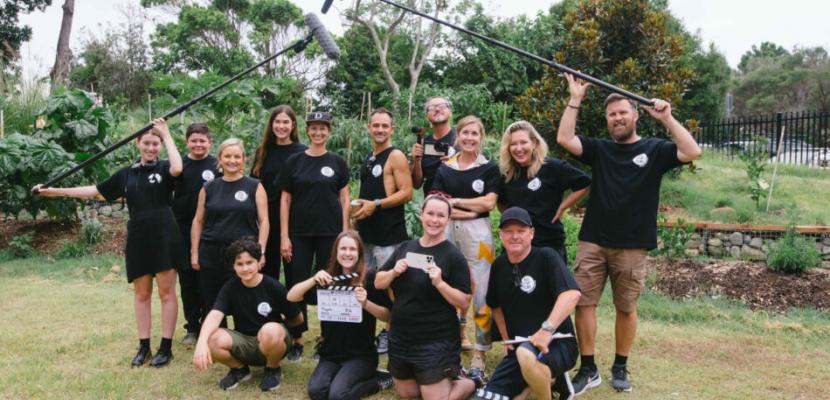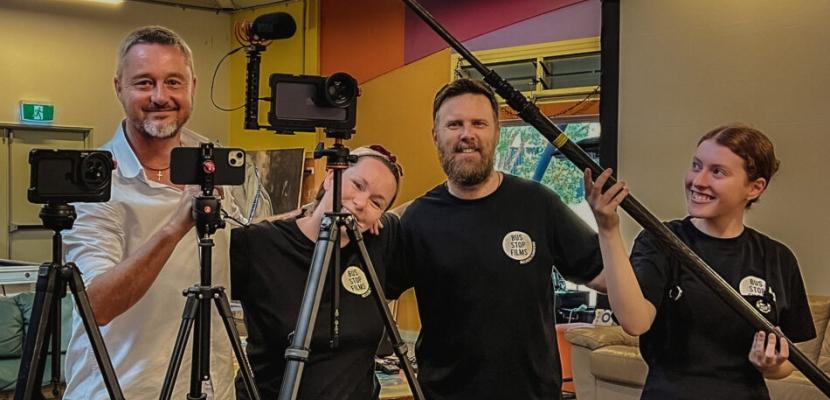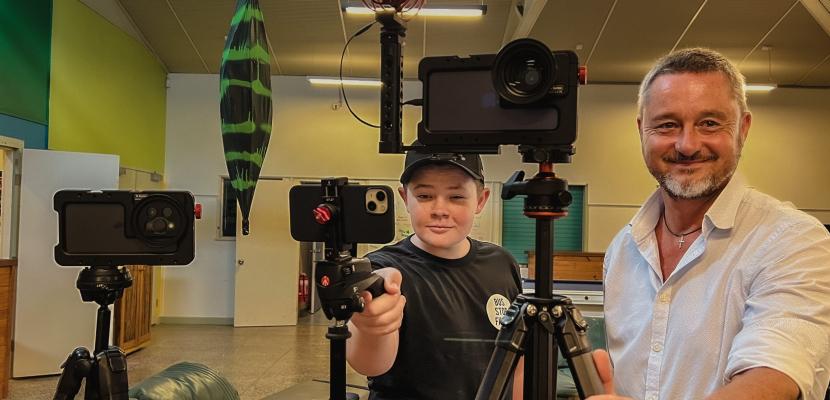
The crew members were all highly experienced. Their CVs included the likes of Nine Perfect Strangers with Nicole Kidman, Elvis with Baz Luhrmann, and Alien: Covenant with Ridley Scott, among others.
It was a small set but there was no doubting the professionalism of everyone involved, or their skill sets and abilities, and they were already buzzing by the time I arrived.
I came on as Director of Photography, which is a bit out of step from what I normally do, because I am a journalist, not a DP. In fact, I’m a mobile journalist, which means I use my phone to film video stories autonomously, not traditional cameras with a crew – and it was apparent as I mounted iPhones on tripods that my presence raised crew interest.
So, why me, and why iPhones, for a shoot destined for national television?

For the past seven years, I have been researching, practicing, and teaching mobile journalism in my role as Assistant Professor of Journalism here at Bond University. In this time, I have constantly defined – and redefined – mobile workflows to get the most out of iPhones for video production. This has involved being an active learner, member, and presenter for MojoFest, the largest annual gathering of mobile journalists on the planet, and a trainer of journalists around the world on how to use their phones professionally, from Al Jazeera in Doha to flagship current affairs programs at the ABC, Australia’s national broadcaster.
Increasingly, my work has leant more toward the aesthetic potential of mobile filmmaking. I’m a landscape photographer at heart, and I like to compose visually harmonious scenes, so I have been incorporating these sensibilities more into my work. The hardware and algorithmic advances of the latest iPhones, coupled with the cutting-edge advances of Filmic Pro and accessory lenses from BeastGrip, mean I can now achieve visual qualities I’ve always aspired to but that were previously out of my reach.
This has led me to identify a gap in mobile journalism, in that the potential now exists for mobile journalism and mobile filmmaking to overlap. This idea is at the core of my PhD documentary project, and is what I have been calling, for academic purposes, cinematic mobile journalism (I wrote about this in more detail for The Walkley Magazine, Australia’s equivalent of the US Pulitzers).

As proof of concept of cinematic mobile journalism for my PhD, I shot a short documentary last year in northwest Scotland. It was experimental to some degree (filming ProRes 60 frames underwater, for example, and using BeastGrip’s then-new 1.33 anamorphic lens for the first time), and I didn’t get everything right. But, I learned a lot from it, and the experience gave me much to consider as I move forward with my techniques and workflows. It also earned some modest successes, including public screening at the UN Ocean Conference in Portugal, and Best Documentary at the SF3 Smartfone Flick Fest in Sydney.
And that’s how I came to be on set.
SF3 co-founder Angela Blake engaged me to work on a production run by Bus Stop Films on which she was the director. We were in Byron Bay, an idyllic Australian surfing town renowned for its natural beauty, ‘alternative lifestylers’, and uber-rich residents (Chris Hemsworth lives here – you get the idea), to film a documentary about entrepreneurial children: 'Child Boss'.
Shadowing the crew were kids who had been affected by catastrophic flooding in the region, in which entire communities had been left homeless, and Angela wanted to empower these kids with mobile video skills to tell their own stories.
I was confident I could do the job. I have used Filmic Pro for years, and I have an active interest in understanding light and how to light scenes. I’ve learned a lot from social networking forums, and from studying cinematographers I admire, habitually listening to podcasts by the likes of Roger Deakins and his wife James, and the exceptionally talented Australian cinematographer Ben Allan and his T-Stop Inn.
But I was unsure how the industry professionals on the Byron set would take to me and my phones. At first, the questions were politely tentative: “So, you’re limited to filming at 30 frames?”

Once I started showing them the Filmic V7 interface and my settings – 4K ProRes HQ, 25fps, LogV3, granular controls, automated focus pull – curiosity quickly gave way to astonishment and acceptance, and it was down to business.
I used three iPhones: primary iPhone 14 Pro Max with BeastGrip 1.7 attached to either the main camera or tele camera, framed on the interviewer to enable optical background bokeh; secondary iPhone 14 Pro either wide or tele on the interviewee; and third iPhone 14 set to wide for a slightly different angle on the subject.
At one point we had to position the primary camera tightly into a corner, which meant the gaffer, Noli, couldn’t see the screen, so we used Filmic Remote on another device for him to light the space. In hindsight, Noli could have also used Filmic Remote on the iPad he used to adjust his lights.
From there, our mutual respect saw us collaborate harmoniously for the rest of the day as we set up and lit four locations. I learned a lot from working with such a generous and experienced gaffer.
At lunch, when I started file transfer, it was clear the battery on my primary phone was not going to last the day. The solution: Director Angela handed me her iPhone 14 Pro Max, Filmic V7 running, and we were ready to roll again.

“I think we converted some film peeps into the smartphone world,” Angela said.
As I remind attendees of my workshops, smartphones are merely another tool. As technology advances and image qualities improve more and more people now have access to what was once an exclusive field. I can honestly say that smartphone videography has opened a new pathway that I never dreamed possible.